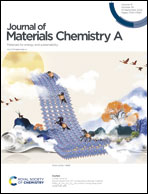Wave-transparent LAS enabling superior bandwidth electromagnetic wave absorption of a 2D pitaya carbon slice†
Abstract
Wave-transparent lithium aluminosilicate glass-ceramic (LAS) nanofillers are confirmed to be effective in regulating the electromagnetic parameters to satisfy the impedance matching characteristic and enhance the electromagnetic wave loss ability. Herein, a new pitaya slice hierarchical configuration of a 2D LAS/carbon sheet electromagnetic wave absorber was prepared by an effective protocol using an ammonium nitrate-assisted self-polymerization and in situ blown strategy. The obtained 2D pitaya hierarchical configuration exhibited excellent microwave absorption performance with an RL of −55.26 dB and a wide effective absorption bandwidth (≤-10 dB) of 8.21 GHz, covering the whole Ku-band (12–18 GHz) with a low mass adding of only 9.2 wt%. The absorbing mechanism demonstrated that the interfacial polarization, Debye dipolar relaxation, and well-matched characteristic impedance play important roles in improving the microwave absorption properties of the 2D pitaya slice hierarchical configuration. This paper may provide a new route for constructing an effective absorbing network of 2D pitaya slice hierarchical configuration, realizing ultra-low filling and broadband microwave performance.



 Please wait while we load your content...
Please wait while we load your content...